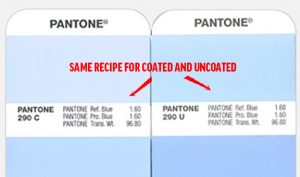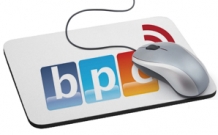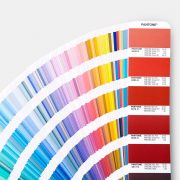Printing: The difference between pantone coated & uncoated. What does it mean for me?
In the world of printing, there are a lot of terms thrown around: stock, foil stamping, Pantone, coated, uncoated… it’s difficult to know what will best meet your particular printing needs.
While Pantone has become the standard in color matching systems for printers and designers, the color you get in the end depends on the type of paper you’re printing on. Deciding when to use coated or uncoated paper can make all the difference when printing collateral for your business.
The difference between coated and uncoated paper
Coated paper, just like is sounds, has been treated with a coating compound in order to reveal qualities of the paper, such as weight or gloss. Coated paper has a smooth finish, and like a pane of glass, absorbs less ink while being more durable.
Uncoated, conversely, has no coating. Generally speaking, uncoated paper is not as smooth, and, like a sponge, soaks up more ink. It’s available in a variety of textures and finishes, making it a little more versatile.
It is also important to note that different paper colors can affect the end-color. Since ink is not opaque, ink on a yellow sheet of paper will look different than a bright white sheet. This may sound like a no-brainer, but you’d be surprised how different an ink can look based on the paper color.
When to use coated versus uncoated paper
So, how do you know what type of paper is right for you? It depends on your particular printing project. Pantone colors are mainly used in offset printing, which uses ink instead of toner. You can print on both a coated and uncoated sheet in digital printing as well, but not all digital printers can handle pantone colors.
Typically, coated paper is used to convey more vibrant color production. Common uses for coated paper include:
- Sell sheets and other advertising materials
- Magazines
- Photography
- Catalogs
- Book covers
Uncoated paper is used for more everyday use, but can also give off a more prestigious and distinguished look. Common uses include:
- Business cards
- Envelopes and other stationary
- Brochures
- Invitations
Some rules of thumb
- Coating restricts how ink bleeds into the paper. When printing sharp and complex images, a coated paper is advantageous.
- Uncoated paper takes longer to dry.
- Coated paper offers more finishings, from gloss and satin to matte or even dull.
- Uncoated paper soaks up ink more than coated, leaving a darker color in its wake. Below is a Pantone guide set for the same color, but you’ll notice the coated (C) is lighter that uncoated (U):

Source: https://graphicdesign.stackexchange.com/questions/36137/how-do-pantone-coated-and-uncoated-colors-relate
Hopefully, these tips will help make paper selection a less daunting task. Whether you’re printing a glossy magazine or company letterhead, BPC has the paper perfect for your every business need.




Leave a Reply
Want to join the discussion?Feel free to contribute!